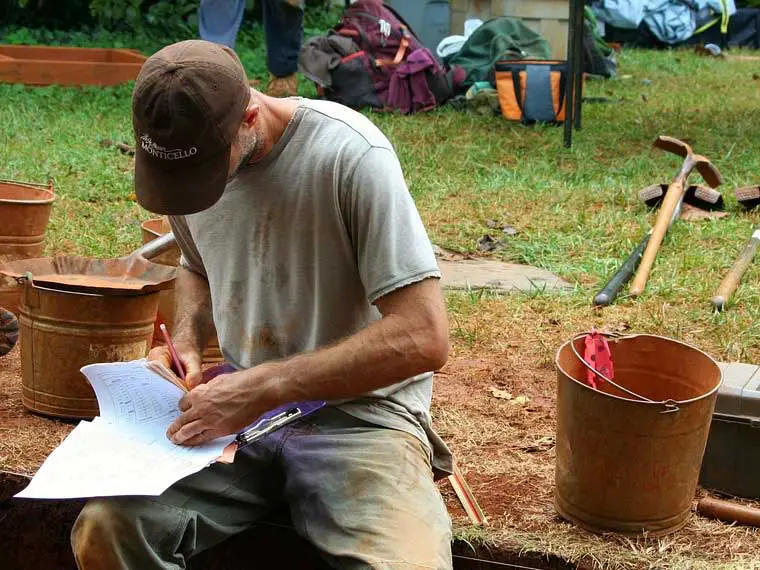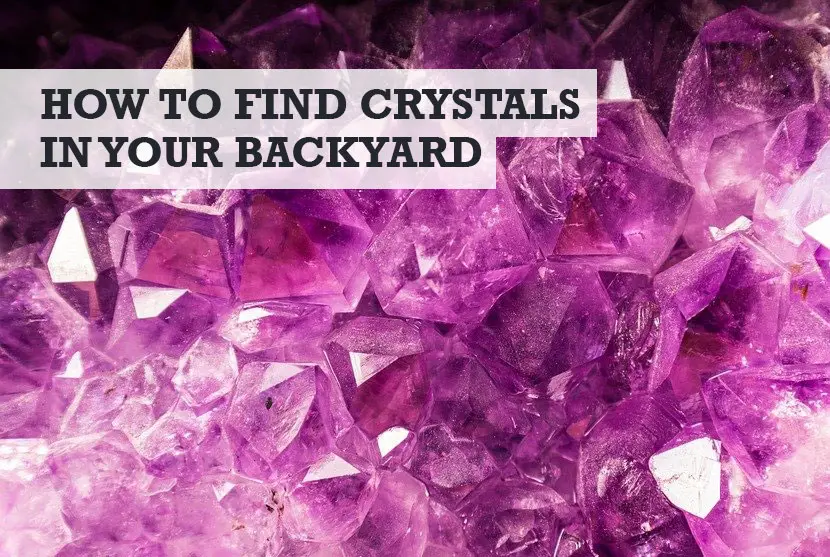You might be lucky enough to have crystals in your backyard. Typically, crystals and gemstones will be found in geographies where deep mantle rocks have been pushed upwards to the earth’s surface. You might also find crystals in rocky areas of your backyard.
How to find crystals in your backyard? You might find crystals in your backyard mixed in within rocky regions or with gravel, in addition to soil. It all depends on where one lives when it comes to finding certain species of crystals.
The following guide was developed for Busy Backyard by Sarah Gee, a writer and outdoors enthusiast. Here she explains how to find crystals in a backyard, including what tools you will need.
Finding crystals in your backyard
When I first started out in trying to find crystals in my backyard, it turned into a bit of a DIY mission. You will need the right tools to do it properly. I started as a beginner, and using digging kits worked for me. I gradually became a novice digger creating my crystal-finding digging kit using items taken from my backyard shed.
I have two properties in different states, and the tools I require to find crystals in my backyards vary depending on the geographical position and soil type.
However, one thing stays constant no matter my site – comfortable clothes. The fun in hunting for crystals is flexibility and unrestricted movement, which is possible when I wear comfy clothes and shoes.
For the most part, I am on my knees. Gardening gloves (view on Amazon) are therefore a must-have since I’ll be digging through the dirt.
Tools needed for finding backyard crystals
Now let’s move to the actual tools. A simple trowel or hand shovel is adequate to break the topsoil layer. The cutting edge could be either pointed or rounded – they both serve the purpose – the one I use is also on Amazon.
However, the soil type and coverage area determine the more preferable tool. The shovel with a rounded cutting-edge are will be more versatile as it requires minimal effort to break the soil.
Sometimes I use a hand shovel; other times, I use one with a long handle when I prefer to explore while standing.
After that, I will use a garden spade, a sifter (see on Amazon), and a bucket. The garden spade varies from the rounded hand shovel. I use it to pour the soil into the sifter to help remove larger dirt particles.
The sifter helps me sieve the chaff from the grain, making it easier to find crystals by separating them from the dust.
When the soil is more refined, I may use a mining pan. In mining, panning is a simple way of removing particles with a higher specific gravity from gravel or dirt by washing them in a pan using water.
I then collect my newfound crystal findings in a bucket – either plastic or metal works just fine.
Optional tools you can use
At my other property, where the soil is more rigid and rocky, I use a pickaxe as it is easier to chip away at rocks, break up boulders, and dig in through compact soil.
A pickaxe is a moderately sized tool made out of a pointed, curved piece of metal that has a long handle attached in the middle. Here’s a great pickaxe on Amazon.
Where to dig for and find crystals in your backyard
The best place to find and dig or backyard crystals will depend on where you live when it comes to finding specific sorts of stones. Do some research in the district to learn which crystals would be most popular.
There are several locations where crystals are not often found, though they may be a habitat to additional intriguing rocks.
Crystals can be found not only within sand particles but in water too. The trick is on the size of the sifter I use, as identifying crystals in water will necessitate a sifter that can separate pebbles and crystals.
When using a sifter, I use different sizes depending on the soil type and the size of particles.
One of the places I avoid digging around is near water, power, electric, and cable lines, as it can be pretty hazardous.

What type of crystals will you find in a backyard
Crystals of various categories may be found all over the world. So, before you start digging in your backyard, do some research to learn what is most common in your region. The more common possibilities include:
Opal
While 95% of the world’s opal is produced in Australia; it can also be found in Honduras, Mexico, Brazil, and western parts of the US. It appears in white, brown, gray, black, and yellow.
Quartz
Standard quartz colors include purple, white, pink, and citrine yellow. It is the one most easily found, geographical setting notwithstanding. However, pure quartz is colorless. Agate, Citrine, and Amethyst are all types of quartz crystals.
Agate
Agate presents in lilac, white, pink, yellow, black, or gray hues. It is most likely to be found in one’s backyard if one resides in the Western part of the United States. I have a better chance of finding this crystal if I live near ancient lava beds.
Obsidian
Mostly found around volcanic rocks, obsidian is tan, green, black, or occasionally brown.
Topaz
This crystal will appear naturally in yellow, green, blue, pink, red, or even orange, sometimes colorless. The world’s imperial topaz is mainly found in Brazil.
Amethyst
Amethyst is distinguished by its rich purple color. This crystal is more likely to be found in the overworld underground, spawning inside caves.
Garnet
Kenya is host to the well-known Scorpion mine, which is notable for its lovely tsavorite garnets.
Other places this crystal can be found are Namibia and Brazil. Arizona, Utah, Carolinas, Idaho, Colorado, California, and Montana have also been known to produce garnet. It is usually dark red.
Jade
Jade crystals are ultimately green and are more commonly found in China, Guatemala, and Russia.
Turquoise
More likely to be found in the southwest parts of the US, turquoise crystals are present in green, blue, or a blend of the two colors.
Peridot
This crystal appears in blue-green, yellow-green, or other variations of green and is mainly found within the deserts of Arizona.
Malachite
Malachite occurs naturally in Australia, Congo, Mexico, Zambia, Gabon, and Namibia, with the largest deposits in Russia. It appears in dark green.
Tourmaline
Easily confused for other more valuable gemstones, it is available in various colors. While not one of the most beneficial crystals, it is still used in jewelry pieces. This crystal is in black, deep brown hues, or bluish-black.
How to clean crystals (and store them)
Once I identify my newfound backyard crystals, I find they are pretty easy to clean and store. There are various methods I use to clean them.
These include using a cleaning crystal, burying them underground for at least twenty-four hours, soaking them in salty water, using rainwater to cleanse them, or putting them outside to recharge on a full moon.
Note that there are two types of cleaning: Energy Cleaning and Hygienic Cleaning. The energy cleansing process restores a crystal’s brilliance, vigor, and optimism. This cleaning type should be considered characteristic and should be done often.
As a result, it is possible to liberate it from outer effects that may linger over it, lest it interferes with its user’s spiritual, emotional, or physical state.
For hygienic cleaning, I use soap and water using a soft, bristle brush. For best results, I soak the crystals in soapy water for approximately 15 minutes. I then rinse them using distilled water to rid them of any other impurities. I then let them dry naturally in sunlight.
Many people use crystals to relax their minds, spirit, and body. Some people think that crystals work energetically by sending natural vibrations outside into the world.
The only way to return your crystal to its original form is to clean and recharge it frequently. This act of kindness may also revitalize my feeling of purpose.
Understanding crystals and how they are created
I used to think of colored minerals each time I heard the phrase “crystals.” However, with time, I learned that minerals and rocks are not the only kinds of crystals.
Crystals include snow, the graphite in pencils, and table salt, to name but a few. Agate, calcite, and peridot are more complex crystals. The molecular compositions of minerals vary. Different molecular compositions combine to produce structures of varying forms.
Take, for illustration, NaCl (sodium chloride) – more popularly identified as table salt. The crystals constitute cubes of Cl (chlorine) and Na (sodium) ions. Six sodium ions surround each chlorine ion. Six chlorine ions surround each sodium ion. It’s repetitious, but that’s what creates it into a crystal. As a result, table salt forms cubic crystals naturally.
On the contrary, snow is a kind of ice crystal. It is composed of H2O (water) molecules, which crystallize as flat hexagonal planar crystals. Another example is SiO2 (silicon dioxide) molecules, which form hexagonal prisms which have hexagonal pyramids on each end, forming quartz crystals.
In a simple definition, a crystal is any dense substance in which the surface regularity mirrors its internal symmetry, and all component atoms are organized in a specific pattern.
Conclusion
We would like to thank Sarah for contributing to Busy Backyard. If you go and find crystals in your own backyard after reading this guide, we’d love to hear from you – and please do send us photos!
You might also like…
Image in header via https://pixabay.com/photos/gemstone-amethyst-602252/





